To the succulents and cacti are favored in difficult landscapes and garden plans because they can adapt to a wide range of conditions, including poor soil and irregular watering. They have the ability to store excess amounts of water in their stem, root, or fleshy leaves, or have additional adaptations, such as hairs on the leaves, to reduce water loss.
Starting and Growing Succulents

Além da família dos cactos com milhares de espécies, existem mais de 60 famílias de plantas que contêm plantas suculentas de várias formas e hábitos de crescimento. Dependendo da espécie, você pode cultivá-las a partir de vários materiais de plantio ou comprar plantas jovens ou espécimes maduros em viveiros.
Growing from seeds
Succulents are flowering plants that usually produce numerous seeds. If you sow sedum or portulaca seeds, you will get several plants at once, but the seeds and seedlings are small and difficult to handle. There is always a risk that the seedlings will not suit the variety as well. Plant these popular seeds as follows:
- Cacti have seeds embedded in the fleshy pulp of their fruits. Clean and dry them before sowing.
- Yuccas and agaves carry relatively large seeds inside their dry pods that usually produce good results when sown. They should ideally be sown in deep pots to accommodate their long roots.
From stem cuttings
Most people find it easier to grow large numbers from cuttings.
- Make a clean cut to remove a section of stem with a crown of leaves.
- Allow the cut end to dry and form a callus (a layer of repair tissue) before planting in a well-draining medium such as sand and perlite.
- Water the succulents once and let the medium become almost dry before watering again.
Most stems will root without any rooting hormone. Cacti, sedum, aeonium, and crassula are easily grown from stem cuttings.
Of puppies
Many clumping and rosette-forming succulents, such as agaves, yuccas, echeveria, sempervium, and similar varieties, form pups (offsets) from their base.

They can be separated from the parent plant and planted. Several species of semperviums, such as Echeverias and Jovibarbas, which are known as hen and chicks, feature plants surrounded by a multitude of offspring, each capable of becoming a new plant when separated from the parent and planted separately.
Of leaves
Some varieties of sedum readily make new plants from their leaf bases. Mature leaves that fall naturally from the parent plant can be placed in a bed of moist sand. They will put out small plantlets and roots from their base. You can gently pinch off a leaf or two and try your luck there, too. Many species of kalanchoe develop small baby plants with roots attached from the teeth on the leaf margins. These eventually fall and take root in the soil below. You can pluck these and plant them in moist sand.
Cultural requirements
Cacti and succulents are easy-care plants, no doubt, but they do have some cultural requirements.
Provide Sun Exposure
Succulents do best in a sunny position, although many can adapt to partial shade with greener leaves and suppressed flowering. Too little light will result in weak stems that stretch too far. Six hours of direct sunlight is ideal. Many sedums that normally form compact heads will have spaced leaves if they don't get enough sunlight.
However, in very hot weather, excessive sun exposure can stress the plant and cause it to develop reddish pigments known as stress coloration. These highlights may make the plants more attractive than their normal counterparts, but repeated stress can affect the health of the plant.
Keep the surrounding area clean

Succulents don't like dead, decaying vegetation around them as much as other plants. Try to remove all debris from around the base of the plant. Non-organic mulch with gravel and pebbles is preferable to bark and other organic mulches.
Water only when necessary
Succulents don’t need as much water as most other plants. Since they can store water, it’s best to water them deeply but occasionally. There’s no set ideal watering interval, but you’ll gradually learn what works for each type of plant you have.
Raspe o solo com uma vara para verificar a umidade antes de regar. O solo deve estar quase seco. Ao contrário das plantas de folhas finas, muitas suculentas não murcham facilmente. No entanto, eles mostram sinais de escassez severa de água ao deixar cair as folhas ou parecer apáticos com folhas e caules de cores opacas.
Ensure good drainage
Overwatering is considered the biggest enemy of succulents, but more than the amount of water given, it is the lack of drainage that causes problems. Many, including cacti, grow well in areas that receive a lot of rain, as long as the rainwater drains away quickly. They do very well on natural slopes.
Before planting one in your desired location, dig a large hole and fill it with sand, gravel, compost, and soil. If you’re planning a drought-resistant landscape with mostly succulents, it’s worth creating artificial slopes to increase drainage.
Feed less
Many varieties of larger plants are slow growers, but a little feeding can speed up their growth. Since these plants can grow in poor soil, it is a bad idea to feed them unnecessarily. Some plants may develop split stems when chemical fertilizers are used. These damaged areas can develop infections. Excessive growth also increases maintenance. Natural slow-release fertilizers, such as bone meal or fish emulsion, can be used occasionally in the spring or summer, but never when the plants are dormant. Succulents that bloom profusely may appreciate some additional feeding before and after flowering.
Pest and Disease Control

Cacti and succulents are generally pest-free, but sap-sucking insects such as mealybugs, scale insects, and aphids can occasionally be a problem. Container-grown plants can be cleaned by hand, but chemical treatments may be necessary for larger garden plants. Take control measures as soon as you spot pests. Severely infested plant parts should be cut off and burned.
Keeping the environment clean and dry and ensuring good air circulation can go a long way in preventing bacterial and fungal rot, a relatively common occurrence. Plants should not be watered by spraying. Water droplets on leaves and stems trigger rot.
Container and Internal Care
Most plants do very well in pots. Whether your collection came from seeds or from some vegetative parts, you will have the best success if you plant them as early as possible. Rooted plants hate to be moved, so they should be planted in their final destinations when the roots are still thin and hair-like. Seedlings develop a long taproot very early in life and can become stunted unless they are placed in tall pots.
Individually potted plants

Attractive groupings of small succulents are often available for sale. This is a good way to get several varieties on the cheaper side. However, they may not all have the same cultural needs. Additionally, their growth habits may not be compatible, with some vigorous types quickly taking over the container at the expense of the more delicate ones. You'll give them a better chance by potting them individually. You can make your own grouping later, once you know the needs of each plant.
Drainage
Succulents do not like compacted, soggy soil. Coarse, fast-draining soil is preferred. Pots should have large drainage holes. Root rot due to overwatering in the root zone is the main reason for the loss of many valuable plants.
Container Care in Cold Weather
If you live in a colder, frost-prone area, it’s always wiser to grow the bulk of your collection in individual containers or communal plantings in large tubs. You can find cold-hardy succulents that can survive outdoors these days, but tender ones should be moved indoors at the first sign of frost.
Their fleshy leaves and stems can be irreparably damaged if exposed to frost. Allow the plants to rest by cutting back on water as the cold season approaches. Their light requirements may also be considerably reduced if the plant is dormant.
Troubleshooting Tips
Common problems you may face usually have fairly simple solutions.
- Leaf drop can be caused by too little or too much watering. Check the soil before watering and ensure good drainage.
- Spindly plants may be due to too little light. Move to bright light or direct sunlight.
- White fuzz under the leaves is a sign of mealybugs. Yellow crusts on stems and young stems mean you may have aphids. Dab the leaves with cotton wool soaked in rubbing alcohol or spray them with insecticide.
- Brown spots or holes on the leaves mean water droplets on the leaves. Do not spray water on the foliage. Water only the roots.
Research before you buy
While succulents aren’t particularly difficult to grow, it’s important to do your research before purchasing. This will ensure that you know the needs of the plants you have and can best meet those needs for vibrant, beautiful plants.
Echeveria Succulent Varieties and Gardening Guide

Echeverias are a large group of succulents native to Central and South America. Known for their amazing variety of leaf colors and shapes, they make an exquisite addition to cactus gardens, patio planters, and even indoor terrariums.
Echeveria Basics

These perennial succulents are tiny, rarely growing more than a few inches tall and slowly spreading across the ground to form small patches. They come in rosette form and reproduce by means of small offsets, miniature versions of the parent plant, which pop up all over the place. Tiny flowers appear in summer, which resemble asters. Their exotic shape is best seen up close, such as in a rock garden or planter.
Increasing requirements
Echeverias tolerate light frost, which has the effect of enhancing the color of their leaves, but they die in temperatures much below 30 degrees. They are easiest to grow in pots, an approach that allows you to bring them indoors during the winter.
They tolerate full sun or partial shade outdoors and are more than happy to overwinter in a sunny window. Special care should be taken with their soil. They can be grown in a commercially prepared cactus mix, lightweight potting mix, or garden soil that has been mixed with some sand or gravel. These are essentially desert plants. They do need some water, but the soil should be allowed to dry out completely between waterings. Fertilizer is not necessary.
Gardening with Echeveria

Echeverias have such specific growing requirements that if you’re not growing them in an arid climate, they’re best grown in a pot. Pair them with other succulents or perennials that also like dry conditions, like euphorbias or even lavender and rosemary. Avoid mixing them with plants that have large, lush leaves or a sprawling growth habit. Echeverias will quickly become overgrown and overshadowed.
They make a great addition to cactus gardens, as they form a beautiful ground cover to contrast the upright growth habit of cacti, and their colorful leaves set off the cacti’s signature deep green color. Place rocks strategically throughout your cactus garden and plant your echeveria so it can wander over and around them.
Echeverias do wonderfully in terrariums, but not the kind with lids. These trap moisture and humidity, which is deadly to echeverias. Instead, grow them in large glass globes, using colored sand to cover the soil around them.
Maintenance
These are very low-maintenance plants. Water succulents lightly every few weeks and keep weeds at bay. A mulch of fine gravel or pebbles in a contrasting color to the variety being grown is a great way to highlight the foliage color and helps prevent rot.

The small offsets that form continuously around the base of each larger rosette can be cut and planted nearby. They form roots in contact with the soil and are a convenient way to spread plants over a larger area.
Aside from rot caused by overwatering, echeverias rarely suffer from pests and diseases. The two exceptions are sap-sucking insects, mealybugs, and aphids. If they do get out of control, treatment is simple using an insecticidal soap or neem oil, both natural products.
Varieties
There are hundreds of varieties of echeveria available, from the cute to the bizarre.
- Echeveria agavoides resembles a miniature agave plant with red tips at the end of its green leaves.
- Blue Cloud has otherworldly blue foliage.
- Huffs Pink has bluish foliage tinged with pink.
- Variegata has green leaves with cream-colored stripes and a hint of pink.






An alien plant
Echeverias have a truly otherworldly presence. Although they are in the plant kingdom, their unusual foliage makes them look like something from an artist’s imagination rather than a living organism.
How to water succulents correctly (without overdoing it)

Watering succulents can be tricky. It’s very important to avoid overwatering them, as they won’t survive if they’re kept too moist. However, they also can’t be allowed to dry out. The key to watering succulents effectively is to let them dry out between waterings. A variety of factors affect how long it takes for a plant’s soil to dry out, so there’s no set number of days a succulent should go between waterings. Review the instructions below to find out how to water succulents properly.
How to Know When a Succulent Needs Water
Succulents are drought-tolerant plants that should only be watered when they are very dry. The best way to tell if a succulent needs water is to check how dry the soil is. Use one of the following methods to tell if a succulent needs watering:
- Moisture meter: Use a moisture meter to determine when a succulent needs water. This simple device measures moisture on a scale of one (driest) to 10 (wettest). When the meter's moisture level is one or two, the plant needs water.
- Toothpick/chopstick method: Alternately, stick a skewer or chopstick into the soil and leave it there for about five minutes. When you remove it, look to see if there is a line of water on it. If there isn't, the soil is dry and the plant needs to be watered.
You should also keep an eye on the leaves of your succulent. When they aren’t getting enough water, their leaves will wilt, dry out, become flat, and/or turn brown. If you notice this happening to a succulent, check the soil to make sure that lack of water is the problem before adding more water.
How to Water Succulents in Pots with Drainage Holes
Ideally, succulents should be planted in a well-draining growing medium so that water doesn’t sit in the container. If water sits in the container or the soil is too wet, the plant’s roots will rot. It’s best to use the “soak and dry” watering method with most cacti, whether you keep them indoors or outdoors.
- Test the soil to determine if the soil is dry enough for the succulent to need water. If the soil is not dry, do not water the plant. If it is dry, follow the steps below.
- Gently pour the water directly onto the soil using a watering can, squeeze bottle, measuring cup, glass, or any other similar container. Do not use a sprayer or mister.
- Pour water into the soil until water runs out of the drainage hole in the pot. Stop once this happens. This will ensure that the soil is soaked.
- Do not water again until the soil is completely dry.
How to water succulents from below
Bottom watering is an option for succulents planted in containers with drainage holes. Once the soil is completely dry, grab a bowl, tub, or similar container that is large enough to hold the potted succulents you want to water. Pour enough water into the container so that the water reaches the middle of the plant containers when placed in the water. Place the containers in the water and let sit for five to ten minutes. This will allow the roots to soak in the water from the bottom up.
How to water succulents in pots without drainage
When watering succulents in a container without drainage, add water carefully so that it only drains about two to three inches. There is no drainage hole in the bottom of the container for water to run through, so it's important to avoid completely saturating the growing medium. Notice: If you are growing a succulent in a pot without drainage, it is important to place a layer of gravel or pebbles in the bottom of the container before filling the rest of the way with a mixture of potting soil and perlite.
How to Water Succulents in Moss
Moss repels water when it’s dry. So if you’re growing a succulent in moss, you can’t just pour water on it until the container drains. Instead, you’ll need to soak the moss several times first so it absorbs the water. So instead of waiting for the moss to dry out completely before watering, you should water your cactus while the moss is still slightly damp. This will make it easier for the moss to absorb the water, so you won’t have to pour water into the container as often. Notice: If your plant container does not have drainage holes, you will need to pour out the water as soon as you are done watering.
How to Water Epiphytic Cactus Plants
Epiphytic cacti are not desert plants. Instead, they are native to high-altitude rainforests that are humid and receive a lot of rainfall. As a result, they require more water than other cacti. It’s okay to water these cacti when they’re still damp, although it’s also a good idea to let them dry out before watering them. It’s also important to mist epiphytic cacti because they need moisture. Squirt these succulents gently with water from a spray bottle at least once a week. If you live in a particularly dry area, more frequent misting is a good idea.
How to Water Succulents in Winter
Most succulents, including epiphytic cacti, go dormant during the winter months. During the winter, you should only water your succulents when the soil is very dry. Cacti will take longer to dry out in the winter than they do in the summer. You won't need to water them as often during the winter months as you do during the rest of the year.
Grow beautiful succulents
Now that you know how to properly water succulents in a variety of ways, you have all the information you need to give these plants enough water without over-watering them. Armed with this information, you’ll be ready to do a great job growing beautiful succulents.
Did you like this amazing tip? If so, share it with your friends and on your social networks. Leave your comment below and your suggestions. Receive it daily here on our website. Blog of ideas and tips free and follow us on Google News too. Thank you!